Implementing asset tracking for agriculture and smart cities
Developers of Internet of Things (IoT) and asset tracking devices and systems for industry, agriculture and smart cities need a way to communicate over long distances at minimal power for extended periods of time. Rich Miron, Applications Engineer at Digi-Key Electronics, explains.
Wireless technologies such as RFID tags, Bluetooth and WiFi are already widely used for asset tracking solutions, but they have limited range and consume too much power. What is required is a combination of GPS and an adaptation of infrastructure such as cellular networks that are already widely deployed and are designed for communications at longer ranges than are available with WiFi or Bluetooth.
LTE-based cellular networks were originally designed for wide bandwidth wireless connectivity for mobile products and devices. IoT applications, on the other hand, can get by using lower power, narrowband cellular technologies such as long-term evolution for machines (LTE-M) and Narrowband IoT (NB-IoT). Still, RF/wireless design is difficult, and developers lacking extensive experience, particularly with respect to cellular, face great difficulty implementing a functioning design that optimises wireless performance and power consumption, while also meeting international regulatory guidelines for both cellular and GPS location services, as well as specific carrier requirements.
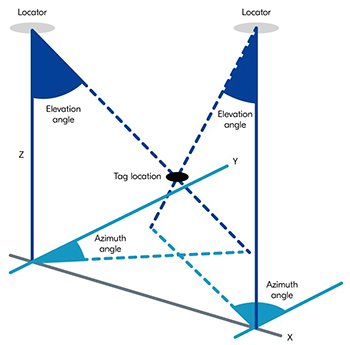
Above: Figure 1. Advanced direction-finding capabilities in Bluetooth support precision location of a tag in three-dimensional space. (Image source: Nordic Semiconductor)
This article describes the trends and design requirements of asset tracking. It then introduces a GPS and cellular narrowband system-in-package (SiP) solution from Nordic Semiconductor and shows how it can greatly simplify the implementation of GPS-enabled cellular devices for asset tracking and other agriculture and smart city IoT applications.
Why asset tracking is increasingly important
The ability to ship products efficiently is vital to commerce: Amazon alone shipped an estimated five billion packages in 2019, spending almost $38bn in shipping costs - a 37% increase over 2018. For any shipping company, delays, damage and theft place a significant strain on manufacturers, distributors and customers. For Amazon, nearly a quarter of those shipped packages were returned - 21% because the customer received a damaged package.
Amazon is by no means alone in allocating a significant portion of their budget to shipping. According to the 2020 State of Logistics report from the Council of Supply Chain Management Professionals (CSCMP), companies spent nearly $1.7tn on shipping costs in 2019 - an expenditure that accounts for 7.6% of the US gross national product (GDP). At these levels, the ability to track packages, identify delays and instances of damage can provide significant benefit to suppliers and purchasers to correct shipment problems.
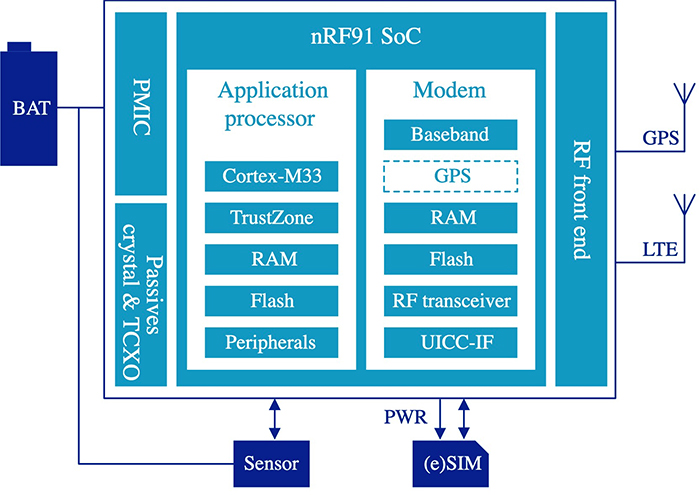
Above: Figure 2. The Nordic Semiconductor nRF9160 SiP combines an SoC with application processor and LTE modem, with other components needed to implement a compact low power cellular-based design for asset tracking or other IoT applications. (Image source: Nordic Semiconductor)
Besides following packages through the supply chain, most enterprises need improved methods for tracking their own assets and locating misplaced items. Yet, half of all businesses still manually log assets, and of those, many rely on employees to search through warehouses, plants, and physical locations to find those thata are missing.
Comparing connectivity technologies for asset tracking
Although a number of solutions have emerged to help automate asset tracking, the underlying technologies have limited coverage area, are expensive per unit cost, or have high power requirements. The latter is critical as asset tracking and remote IoT devices are battery powered devices.
Conventional tracking methods based on passive radio frequency identification (RFID) cannot provide live data in transit and require packages to pass through some physical checkpoint to detect the RFID tag attached to a package. Battery powered active RFID tags are able to provide real-time location data but require additional infrastructure and remain limited in coverage.
Compared to RFID tags, Bluetooth Low Energy (BLE) and WiFi offer progressively greater range within a coverage area equipped with fixed locators for each technology. Building on a rich ecosystem of devices and software, BLE and WiFi are already applied in location-based applications such as COVID-19 contact tracing and conventional real-time location services (RTLS), respectively. With the availability of direction finding features in Bluetooth 5.1, the location of a tag can be accurately calculated based on angle-of-arrival (AoA) and angle-of-departure (AoD) data (Figure 1).
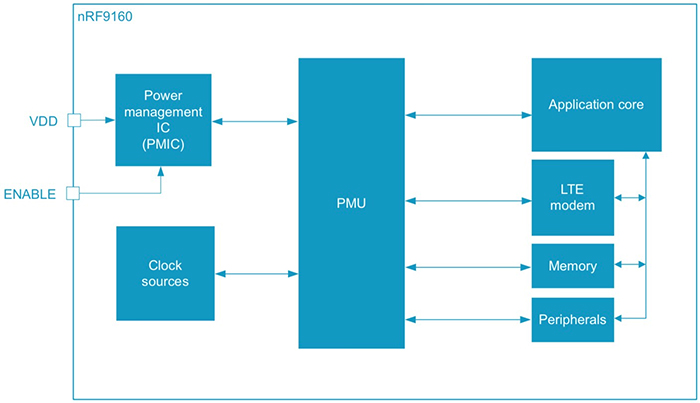
Above: Figure 3. The nRF9160 SiP includes a PMU that automatically controls clocks and supply regulators to optimise power consumption. (Image source: Nordic Semiconductor)
While BLE applications remain limited to short-range applications, WiFi’s greater range can make it effective for use in asset tracking applications within a warehouse or enterprise campus. Yet, WiFi RTLS tags are typically expensive devices with power requirements that make batteries impractical, thereby limiting its use to tracking larger, expensive assets. At the same time, large-scale deployments using either of these technologies can suffer from increasing noise in their reception bandwidth, leading to lost or corrupted packets and degradation of location detection capabilities.
Despite their potential use for tracking assets locally, neither RFID, BLE nor WiFi can provide the range of coverage needed to easily track an asset once it leaves the warehouse or enterprise campus. The ability to track a package or piece of equipment regionally or even globally depends on the availability of a wireless technology able to achieve both extended reach and low power operation.
Alternatives based on low-power ultra-wideband (UWB) technologies can achieve significant range but network coverage remains limited. In fact, few alternatives can provide the kind of global coverage already available with low-power wide-area network (LPWAN) cellular solutions based on LPWAN technology standards defined by 3rd Generation Partnership Project (3GPP) - the international consortium that defines mobile communications standards.
Achieving global reach with cellular connectivity
Among 3GPP standards, those based on LTE-M and NB-IoT technologies are designed specifically to provide a relatively lightweight cellular protocol well matched to IoT requirements for data rate, bandwidth and power consumption.
Defined in 3GPP Release 13, LTE Cat M1 is an LTE-M standard that supports 1 megabit per second (Mbit/s) for both downlink and uplink transfers with 10 to 15 millisecond (ms) latency and 1.4 megahertz (MHz) bandwidth. Also defined in 3GPP Release 13, Cat-NB1 is an NB-IoT standard that offers 26 kilobits per second (Kbits/s) downlink and 66 Kbits/s uplink with 1.6 to 10s latency and 180 kilohertz (kHz) bandwidth. Defined in 3GPP Release 14, another NB-IoT standard, Cat-NB2 offers higher date rates at 127 Kbits/s downlink and 159 Kbits/s uplink.
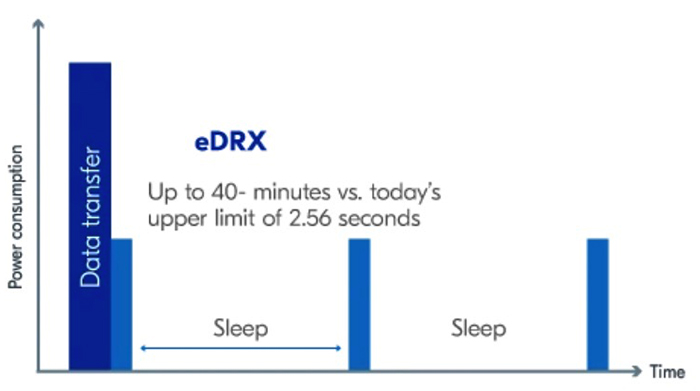
Above: Figure 4. The nRF9160 SiP's modem supports extended discontinuous reception which allows devices to achieve dramatic power savings by sleeping for a period of time negotiated with the cellular network. (Image source: Nordic Semiconductor)
Although the specific characteristics of these two broad classes of LPWAN technology lie well beyond the scope of this brief article, both can serve effectively for typical asset tracking applications. Combined with sensors and global positioning satellite (GPS) capabilities in compact packages, asset tracking solutions based on LTE-M or NB-IoT based cellular LPWANs can support the kind of capabilities required for asset management and end-to-end logistics.
Given LPWAN’s potential for achieving greater efficiency and cost savings, cellular LPWAN continues to play a greater role in logistics. With the availability of the nRF9160 SiP from Nordic Semiconductor, developers can more quickly and easily serve the growing demand for LPWAN-based devices needed for more effective asset tracking or other IoT applications.
Delivering a drop-in asset tracking solution
Nordic Semiconductor’s low-power nRF9160 SiP device combines a Nordic Semiconductor nRF91 system-on-chip (SoC) device with support circuitry to provide a complete LPWAN connectivity solution in a single 10 x 16 x 1.04mm land grid array (LGA) package. Along with an Arm Cortex-M33-based microcontroller dedicated to application processing, nRF91 SoC variants integrate an LTE-M modem in the NRF9160-SIAA SiP, NB-IoT modem in the NRF9160-SIBA SiP, and both LTE-M and NB-IoT as well as GPS in the NRF9160-SICA SiP. Furthermore, the nRF9160 SiP is pre-certified to meet global, regional and carrier cellular requirements, allowing developers to quickly implement cellular connectivity solutions without the delays typically associated with compliance testing.
All SiP versions combine the microcontroller-based application processor and modem with an extensive set of peripherals, including a 12-bit analogue-to-digital converter (ADC) often needed in sensor designs. The SiP further packages the SoC with an RF front-end, power management integrated circuit (PMIC), and additional components to create a drop-in solution for LPWAN connectivity (Figure 2).
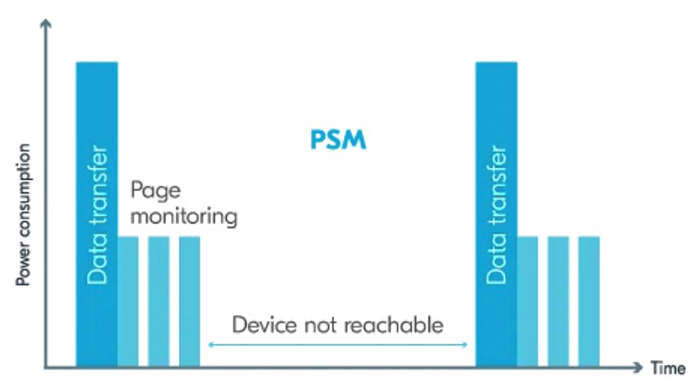
Above: Figure 5. The cellular PSM protocol allows devices to take advantage of low power sleep modes without incurring the power costs of reattachment by negotiating specific periods when they are not reachable. (Image source: Nordic Semiconductor)
Serving as the host processor, the SoC’s microcontroller integrates a number of security capabilities designed to meet the growing demand for security in connected devices, including IoT devices and asset tracking systems. Building on the Arm TrustZone architecture, the microcontroller embeds an Arm Cryptocell security block, which combines a public key cryptography accelerator with mechanisms designed to protect sensitive data. In addition, a secure key management unit (KMU) provides secure storage for multiple types of secret data including key pairs, symmetric keys, hashes, and private data. A separate system protection unit (SPU) also provides secure access to memories, peripherals, device pins and other resources.
In operation, the SoC’s microcontroller serves as the host, executing application software as well as starting and stopping the modem. Other than responding to start and stop commands from the host, the modem handles its own operations using its substantial complement of integrated blocks including a dedicated processor, RF transceiver, and modem baseband. Running its embedded firmware, the modem fully supports 3GPP LTE release 13 Cat-M1 and Cat-NB1. Release 14 Cat-NB2 is supported in hardware but requires additional firmware to operate.
Achieving low power cellular connectivity
The nRF9160 SiP combines its extensive hardware functionality with a full set of power management features. Its included PMIC is supported by a power management unit (PMU) which monitors power usage and automatically starts and stops clocks and supply regulators to achieve the lowest possible power consumption (Figure 3).
Along with a System OFF power mode, which maintains power only to circuits needed to wake the device, the PMU supports a pair of System ON power sub modes. After power-on-reset (POR), the device comes up in the low-power sub mode, which places functional blocks including the application processor, modem, and peripherals in an idle state. In this state, the PMU automatically starts and stops clocks and voltage regulators for different blocks as needed.
Developers can override the default low-power sub mode, switching instead to a constant latency sub mode. In constant latency sub mode, the PMU maintains power to some resources, trading an incremental increase in power consumption for the ability to provide a predictable response latency. Developers can invoke a third power mode using the external enable pin, which powers down the entire system. This capability would typically be used in a system design that uses the nRF9160 SiP as a communications coprocessor controlled by the host system’s main processor.
These power optimisation features enable the SiP to achieve the kind of low power operation needed to ensure extended battery life in an asset tracking device. For example, with the microcontroller in the idle state and the modem powered down, the SiP consumes only 2.2 microamps (μA) with the real-time counter active. With the microcontroller and modem both off and power maintained only to the general purpose input output (GPIO)-based wakeup circuitry, the SiP consumes only 1.4μA.
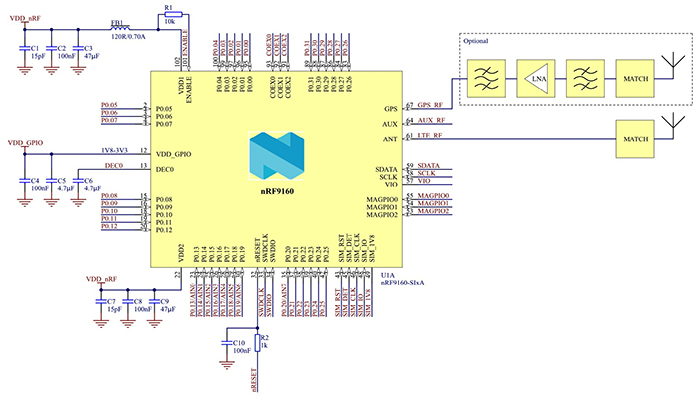
Above: Figure 6. Using the Nordic Semiconductor nRF9160 SiP, developers need few additional components to implement the hardware design for a complete cellular-based asset tracker or other IoT device. (Image source: Nordic Semiconductor)
The SiP continues to achieve low power operation while executing various processing loads. For example, running the CoreMark benchmark with a 64MHz clock requires only about 2.2 milliamps (mA). Of course, as more peripherals are enabled, power consumption rises accordingly. Still, many sensor-based monitoring applications can often operate effectively at reduced operating rates that help maintain low power operation. For example, current consumption for the integrated differential successive approximation register (SAR) ADC drops from 1,288mA to less than 298mA when switching from a high accuracy clock to a low accuracy clock for sampling in either scenario at 16 kilosamples per second (Ksamples/s).
The device also uses other power optimisation features for its other functional blocks including GPS. In normal operating mode, continuous tracking with GPS consumes about 44.9mA. By enabling a GPS power saving mode, current consumption for continuous tracking drops to 9.6mA. By reducing the GPS sampling rate from continuous to every two minutes or so, developers can significantly reduce power. For example, the GPS module consumes only 2.5mA when performing a single-shot GPS fix every two minutes.
The device’s support for other power saving operating modes also extends to the nRF9160 SiP’s modem. With this device, developers can enable modem features supporting special cellular protocols designed specifically to reduce power in battery powered connected devices.
Utilising low power cellular protocols
As with any wireless device, the largest contributor to power consumption, besides the host processor, is typically the radio subsystem. Conventional cellular radio subsystems take advantage of power saving protocols built into the cellular standard. Smartphones and other mobile devices typically use a capability called discontinuous reception (DRX), which allows the device to turn off its radio receiver for a period of time supported by the carrier network.
Similarly, the extended discontinuous reception (eDRX) protocol lets low power devices such as battery operated asset trackers or other IoT devices, specify how long they plan to sleep before checking back in with the network. By enabling eDRX operation, an LTE-M device can sleep up to about 43 minutes while an NB-IoT device can sleep up to about 174 minutes, dramatically extending battery life (Figure 4).
Another cellular operating mode, called power save mode (PSM), enables devices to remain registered with the cellular network even while they are in sleep mode and unreachable by the network. Normally, if a cellular network is unable to reach a device within some period of time, it will terminate the connection with the device and require the device to execute a reattachment procedure that consumes an incremental amount of power. During long-term operation of a battery powered device, this repeated small consumption of power can exhaust or significantly reduce battery charge.
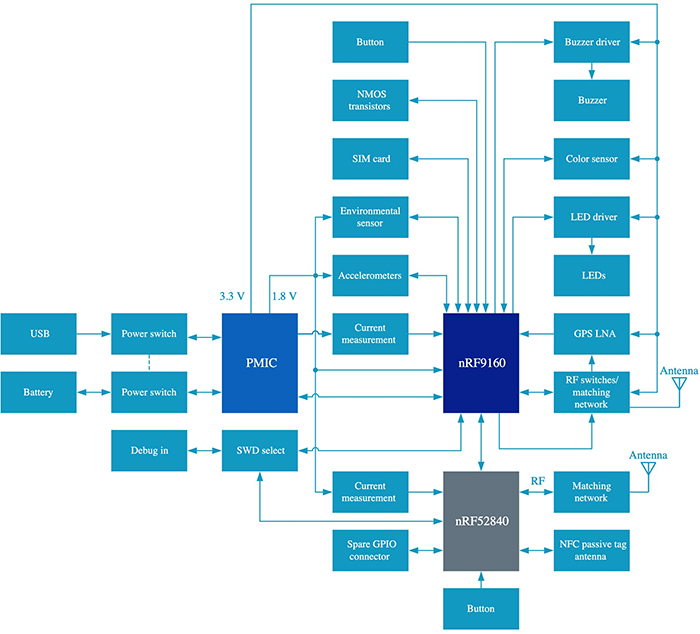
Above: Figure 7. The Nordic Semiconductor NRF6943 THINGY:91 cellular IoT development kit provides a complete platform for rapidly prototyping sensor-based applications with both cellular and Bluetooth connectivity. (Image source: Nordic Semiconductor)
A device enables PSM by providing the network with a set of timer values that indicate when it will periodically become available and how long it will remain reachable before returning to sleep mode (Figure 5).
Because of the PSM negotiation, the carrier network does not detach the device. In fact, the device can wake at any time and resume communications. The benefit is that it uses its low power sleep mode when it has nothing to communicate, without losing its ability to wake as needed and instantly communicate.
The nRF9160 SiP supports both eDRX and PSM, enabling the device to maintain operation with minimal power consumption. When in its unreachable stage with PSM, the device consumes only 2.7μA. eDRX uses only slightly more current, consuming 18μA in Cat-M1 operation or 37μA in Cat-NB1 operation while using cycles of 82.91 seconds.
Developing low power asset tracking solutions
Implementing the hardware design for an asset tracking device based on the nRF9160 SiP requires few additional parts beyond decoupling components, antennas, and those needed for separate matching networks for GPS and LTE antennas (Figure 6).
Developers can easily combine the nRF9160 SiP with a Bluetooth device, such as Nordic Semiconductor’s NRF52840 Bluetooth wireless microcontroller and sensors, to implement a sophisticated sensor-based GPS enabled cellular asset tracker that provides users with access to data through their smartphones and other Bluetooth enabled mobile devices.
Nordic Semiconductor further helps developers quickly begin evaluating cellular-based designs through a pair of development kits. For rapid prototyping of sensor-based asset tracking applications, the Nordic Semiconductor NRF6943 THINGY:91 cellular IoT development kit provides a complete battery powered sensor system that pairs the nRF9160 SiP with an NRF52840 Bluetooth device, multiple sensors, basic user interface components, a 1,400 milliamp-hour (mAh) rechargeable battery, and a SIM card to allow out-of-the-box cellular connectivity (Figure 7).
For custom development, the Nordic Semiconductor NRF9160-DK kit serves as an immediate development platform and reference for new designs. Although it does not include sensors like the THINGY:91, the NRF9160-DK kit combines an nRF9160 SiP with an NRF52840 Bluetooth device, and includes a SIM card along with multiple connectors including a SEGGER J-Link debugger interface (Figure 8).
For software development of an asset tracking application, Nordic includes a complete nRF9160 asset tracking application with its nRF Connect software development kit (SDK). The SDK combines Nordic’s nrfxlib software library for its SoCs, a Nordic fork of the Zephyr Project real-time operating system (RTOS) for resource constrained devices, and a Nordic fork of the MCUboot project secure bootloader.
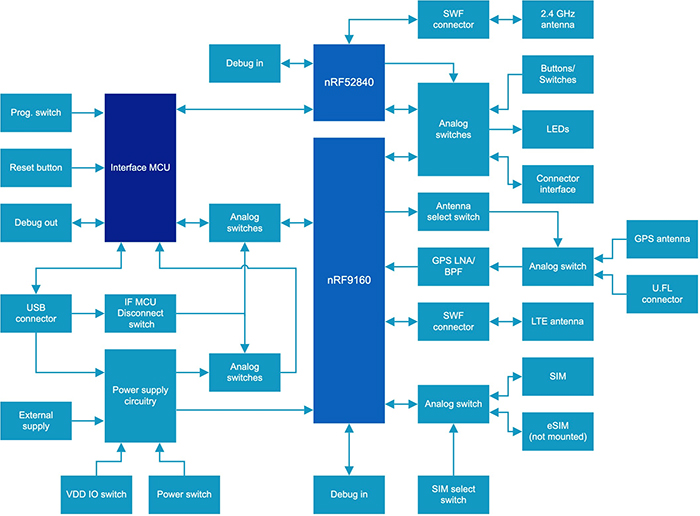
Above: Figure 8. The Nordic Semiconductor NRF9160-DK kit offers a comprehensive development platform for implementation of custom cellular-based applications for asset tracking and other IoT solutions. (Image source: Nordic Semiconductor)
The THINGY:91 and NRF9160-DK kits come preloaded with the asset tracking application designed to connect with Nordic’s own nRF Cloud IoT platform. Using the preconfigured settings with either kit, developers can immediately begin evaluating cellular-based asset tracking and prototyping their own applications.
Along with the preloaded firmware, Nordic provides complete source code for the asset tracking application. By examining this code, developers can gain a deeper understanding of the NRF9160 SiP’s capabilities, and its use in supporting GPS localisation and LTE-M/NB-IoT connectivity in an asset tracking application.
The main routine in this sample software illustrates basic design patterns for implementing a custom asset tracking application. When started, the main routine invokes a series of initialisation routines. Among those routines, one initialisation routine configures the modem and establishes the LTE connection by sending a series of attention (AT) strings to define connection parameters and invoke the modem’s built-in functionality to connect to the carrier network. Another initialisation routine, work_init, initialises a set of Zephyr RTOS work queues including those for sensor, GPS, and development board buttons.
During this initialisation phase, the functions associated with each work queue initialisation invocation perform their own specific initialisation tasks, including those required to perform any required updates. For example, the sensors_start_work_fn function called by work_init sets up a polling mechanism that can periodically invoke a function, env_data_send, that sends sensor data to the cloud.
When running the asset tracker sample application on the Nordic Semiconductor NRF6943 THINGY:91 cellular IoT development kit, the application sends actual data from the THINGY:91's onboard sensors. When running on the Nordic Semiconductor NRF9160-DK development kit, it sends simulated data using a sensor simulator routine included in the SDK. Developers can easily extend this software package to implement their own asset tracking applications or use its code examples to implement their own application architecture.
Conclusion
Using conventional methods, the ability to track valuable packages or locate high value assets across agricultural or smart city environments has been limited to wireless technologies such as RFID tags, Bluetooth and WiFi. Designers need greater range and more accurate location information over longer periods of time. Low-power LTE cellular standards like LTE-M or NB-IoT combined with GPS can meet these requirements, but implementation can be challenging due to the difficulty and nuances of RF design.
As shown, a Nordic Semiconductor SiP provides a near drop-in solution for long range, low-power asset tracking. Using this pre-certified SiP and its development kits, developers can quickly evaluate cellular connectivity, prototype cellular-based GPS enabled asset tracking applications, and build custom asset tracking devices that take full advantage of the extended range and low power requirements of LTE-M and NB-IoT cellular connectivity.











